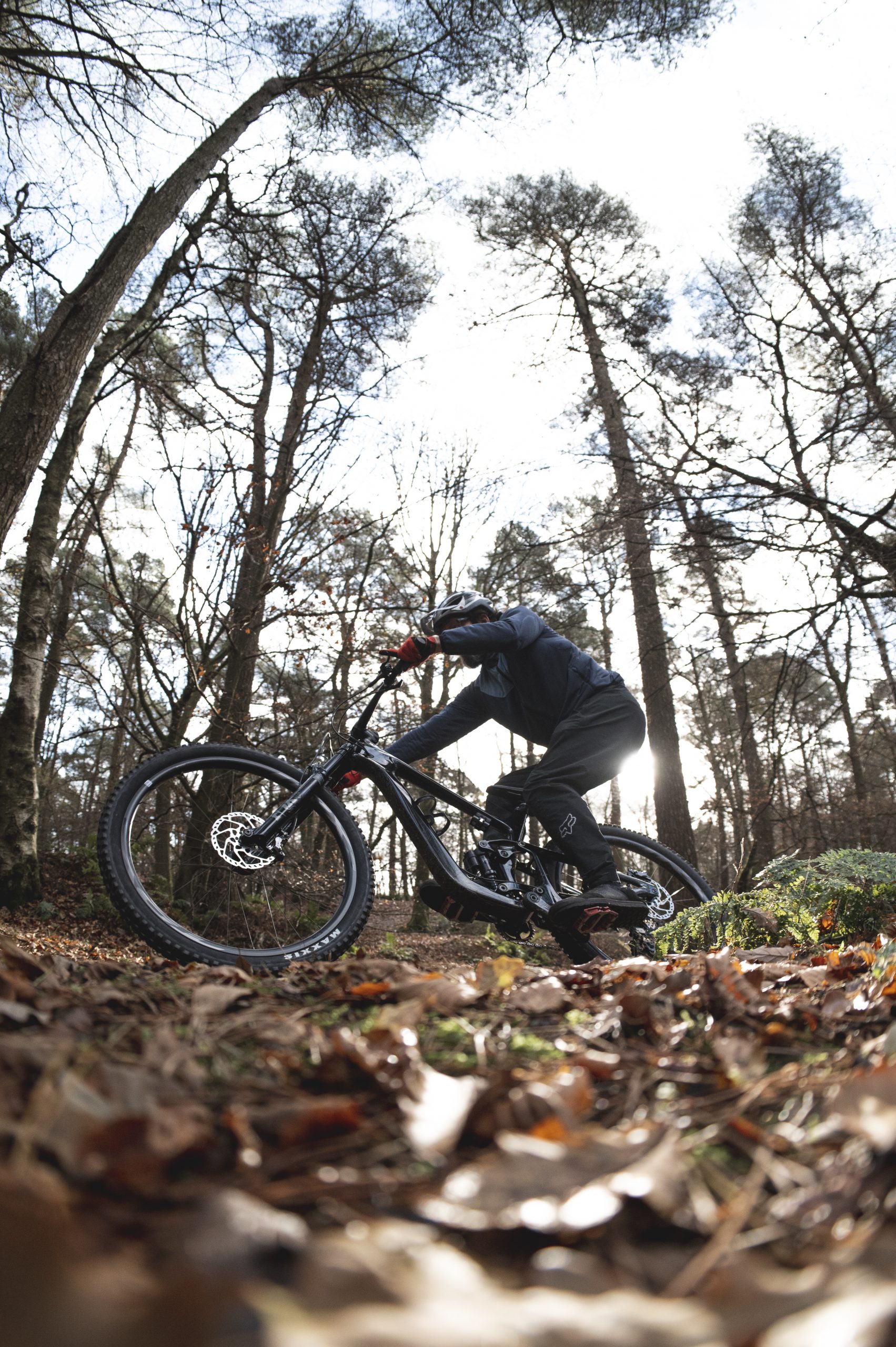Giant's all-swinging trail bike gets 29in wheels, internal frame storage and Fox's sophisticated Live Valve suspension. So does it get the pulse racing on the trails?
Giant Trance Advanced Pro 29 1 review
Fox Live Valve equipped bikes have always demanded a premium. And while that’s unlikely to change any time soon, the recent introduction of the new Giant Trance Advanced Pro 29 1 sporting Fox Performance Elite level suspension makes it the most affordable Live Valve bike to date. Does the addition of this clever suspension kit give it the edge over the best full-suspension mountain bikes?

A small black box under the top tube is where the magic happens. Inside is a rechargeable battery, and the button on the left lets you change the system bias depending on whether you are looking for bump absorption or efficiency.
But make no mistake, this isn’t a dumbed down version of Fox’s electronic suspension system designed to hit a price point. With the addition of Bluetooth connectivity, Live Valve 1.5 opens up a raft of fine tuning options with the dedicated Live Valve app. Other key updates include a reduction in the decline angle at which the suspension becomes active, increased timer duration so the suspension can stay open for longer, and a reduction in the threshold needed to activate the suspension. All positive changes then. Possibly the biggest difference with Live Valve 1.5 though, is that the closed setting is no longer a full lockout, where Fox now refers to it as firm mode.

Being a wired system means Fox Live Valve is more obtrusive than RockShox’s Flight Attendant.
But enough about the electronics. Built around 29in wheels, the full Advanced composite frame of the new Trance delivers 120mm of rear wheel travel. And unlike most bikes we measure, Giant’s precision construction techniques give you every last millimetre from its longstanding Maestro twin-link suspension system.
Designed around a 130mm travel fork, the latest Trance has geometry fitting of a short-travel shredder. With the flip-chip in the upper rocker link set to the low position, the Trance has a 65.5º head angle, low slung 330mm BB height and a pretty standard 440mm chainstay length. Reach on the size L is 471mm, so the bike is long-ish without being overly stretched. It’s available in four frame sizes, and if the idea of having a microprocessor adjusting your suspension on-the-fly seems like a dystopian nightmare, Giant offers options below and above the Trance Advanced Pro 29 1 with conventional suspension components.

Internal frame storage is a useful addition to the Trance Advanced, but the opening is a bit tight.
One final addition to the latest Trance Advanced frame is integrated down tube storage. A small switch on the hatch makes it a cinch to use, but the reinforced cutaway in the down tube is pretty narrow, so there’s an increased risk of stuffing something into your frame and not being able to get it out. In that respect it’s much closer in design to Trek’s Bits system than Specialized’s SWAT design, which is the original glove box and the still the best system we’ve used.

Live Valve uses this sensor on the fork to detect bump inputs.
Suspension
Sensors on the back of the brake arch on the Fox 34 fork and at the rear dropout relay information in real time to the Controller, the little box under the top tube of the Trance. The controller contains the microprocessor, firmware and a 3-axis accelerometer for pitch detection. It’s also where the battery that powers the system attaches.
Based on feedback from all of the sensors, Live Valve toggles the damping in the fork and shock independently between two settings: open and firm. In that respect it’s more binary than RockShox’s Flight Attendant system on the YT Jeffsy Uncaged 6, and it makes initial suspension set-up that much more critical. In a nutshell, Live Valve’s default mode is the firm setting, and only when you hit a bump with sufficient force or get airborne does the suspension open.

You still get to control the level of compression damping in the open mode with a hex key.
Adjusting the threshold determines the level of force that is needed to activate the suspension within each of the five modes: Climb, Firm, Sport, Comfort and Open, where the time that the suspension stays open and fully active is different in each mode. The removable battery on the controller has a power button as there’s no shake to wake feature here. And there’s a second button on the battery for toggling between the five threshold settings so you don’t need to take your phone with you on every ride to fine tune the suspension response.
The battery can be charged on or off the bike with a standard USB cable and a single charge will give 16-20hs of ride time. All of the component parts of Live Valve are hardwired together so you only have one battery to charge. The disadvantage being that there are more wires and the frame needs dedicated routing for the wires, sensors and control unit.

Live Valve took a while to get used to, but Giant’s Trance 29 chassis was exploitable from the get-go.
Components
Fitting the correct amount of seat post drop for each frame size is always tricky, but the new TranzX adjustable dropper that offers 170-200mm of drop on the size L Giant aims to address that. We think the 150-170mm option would be a better choice here though, as it’s normally shorter riders that struggle with seat post insertion.
It’s no secret that we have something of a love/hate relationship with Shimano XT 4-piston brakes. We love the raw power, even with the smaller 180mm rotors on the Giant, but we hate the inconsistent bite point and the incessant rattle from the cooling fin brake pads. Thankfully the Giant comes with regular brake pads fitted, but the XT brakes still present with their hallmark variable bite point.
And while that’s annoying, it wasn’t as bad as repeatedly dropping the chain on the Trance Advanced Pro 1. We initially thought it may have something to do with the Praxis chainring or even the KMC chain. But after increasing the clutch tension in the XT rear derailleur, checking the alignment of the hanger and ensuring that the gears were indexed correctly, we still had the worst case of chain suck and rode in constant fear of the rear derailleur exploding. On closer inspection, and with some photographic evidence, it quickly became clear that a sticky freehub on the Giant TRX2 Carbon rear wheel was the source of the chain suck and chain derailment and swapping the rear wheel instantly cured the issue. It also highlighted that there is a lot more flex in the Giant TRX2 rear wheel than the Crankbrothers Synthesis wheel on the YT.

A stickly freehub on the Giant TRX2 wheel caused huge chainsuck issues.
Performance
With the distraction of the chain suck and slapping derailleur eliminated it was much easier to focus on the performance for the Trance Advanced Pro 1, and specifically the new Live Valve. But before we get into that, let’s discuss how the new Trance rides with Live Valve switched off. In short it’s a push, versatile 120mm-travel trail bike that can be ridden really hard. It has good weight distribution so you always feel centred between the contact patches, and the full carbon frame has a nice flex response that will favour lighter riders. It helps too that the rebound on the rear shock can be set from bullet fast to freight train slow, so regardless of rider weight, it’s easy to achieve a lively and engaging ride from the suspension.

Set up is critical though. Run the rear shock on the Trance with 30 per cent sag and the bike feels mushy and sluggish when pedalling. And while the temptation to use Live Valve to overcome the distinct lack of urgency on the climbs is the obvious solution, it makes the suspension response feel very on/off, with pronounced swings in the dynamic ride height of the bike when it switches from firm to open mode. So you end up using Live Valve more like a remote lockout for climbing rather than a fully automated system. Which kinda defeats the purpose of all the tech, right?
It wasn’t until we reduced shock sag to 25% that Live Valve became less intrusive and more effective. With a firmer baseline suspension set-up and the associated increase in anti-squat, Live Valve allows you to layer on any of the five different suspension tunes to achieve quite different ride characteristics from the bike – where the changes are much more subtle than when running more sag. The only downside to this approach is that we were always well shy of achieving the full 120mm travel, so you’re still going to have to get your hands dirty as theres still some work to be done with the volume spacers inside the shock.
Four key facts
- Giant’s wide 92mm PowerCore BB may well boost frame stiffness, but you have to settle for a Pressfit BB
- The 130mm travel Fox 34 fork has an external compression adjuster to fine tune the suspension response
- Giant’s Maestro twin-link suspension delivers 120mm travel, where the upper link has a geometry adjust flip chip
- The processing power of Fox’s Live Valve electronic suspension sits under the top tube of the Trance Advanced and is hardwired to sensors on the fork and rear dropout
Verdict
We’re not crazy about increasing the number of cables on any bike, but there’s no denying that the latest Fox Live Valve technology allows you to have pronounced differences in the ride characteristics of the bike by simply selecting a different mode in the app. To get the most from the electronics on the Giant Trance Advanced Pro 1 though, you need to be painstakingly precise with the initial suspension set-up. And complex as the Live Valve is, it was actually mechanical problems like the sticky freehub and inconsistent Shimano XT brakes that took the shine of this remarkably capable 120mm trail bike.
















